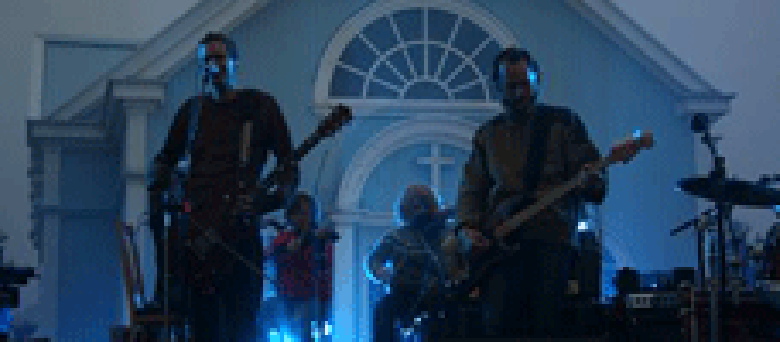Reviews
Sigur Rós – Heima
Dean DeBlois
Iceland, 2007
Credits
Review by Jenny Jediny
Posted on 18 November 2007
Source Klikk/Truenorth Productions Video Projection
External links
Translated, Heima means “at home” or “homeland,” a straightforward title that conveys the very simple ambitions of Icelandic band Sigur Rós in making this rock concert film that occasionally takes on documentary form. For anyone unfamiliar with the band, Sigur Rós formed in the late 1990’s, originally produced ambient noise rock that eventually morphed into sweeping, almost ethereal sound with a rock base, heightened by lead singer’s Jónsi’s falsetto vocals. The band’s songs are notoriously long (ranging from six to thirteen minutes) and many of the lyrics are written in a made-up, gibberish dialect called “Vonlenska,” translated in English as Hopelandic. Heima documents the conclusion of their last world tour, as Sigur Rós, along with female quartet and supporting group Amiina, scheduled a series of free, sometimes unannounced concerts throughout Iceland during the summer of 2006, recording the performance footage along with interviews and accompanying landscape shots.
Heima is a bit of an exception in the genre of concert films, which primarily fall somewhere between uninterrupted concert recordings at specific, often high profile venue shows, and more in-depth documentaries that often capture ruptures between band members (such as Metallica: Some Kind of Monster or the more ambient, but still tense Meeting People Is Easy). Heima, aside from containing live performances, strongly emphasizes the link between Sigur Rós and their native country. The Icelandic Tourism Board should strongly consider licensing images from Heima for promotional purposes; although I hope it’s common knowledge that Iceland isn’t a vast and empty tundra, it’s still overwhelming to see the striking landscape captured on camera in Heima, a jaw-dropping array of sun drenched valleys, craggy mountains, and lucid, cascading rivers and waterfalls.
While one might assume that Iceland would take pride in such beauty, the film sets-up more pressing matters but leaves the details rather vague; for example, there is a conversation on the potential environmental crisis, as interest increases in mining natural properties for fuel and economy, a decision both Sigur Rós and locals find objectionable. However the film never fully explains the extent of these threats to Iceland, nor delves into any great depth of conversation with any of the band members, who seem more comfortable providing succinct thoughts (during the post-screening, our audience witnessed a live Q&A with the band, proving that their interview discomfort was not simply on-screen, although the interviewer’s shoddy questions didn’t help). These half-formed sections don’t necessarily detract from Heima, as the film clearly intends to feel loose and unhurried, although it does occasionally hit snags of repetition. The landscape begins to feel a bit too familiar (if only at the very end of the film), as well as the film’s rhythm, as shots of nature are increasingly cut to during performances, slightly distracting from the music.
However, it is precisely the music that I found more compelling than anything else presented in Heima; while the editing’s insertions and cut-aways eventually lost its effect, the incredibly unique, and Icelandic specific “venues” were never tiresome. Vast highland fields, a breakfast hall, an abandoned factory, and spontaneously constructed, open-air stages all figure in Sigur Rós performances, enabling the camera to move closely among the band as they perform, and provide detailed shots of their highly nuanced instruments, as hands quickly maneuver from a standard bass to glockenspiels and an intricate, handmade xylophone. Having seen the band perform live more than once, I can attest that the filmed performances have an equally hypnotic quality, as I momentarily gazed around the screening room during Heima to see numerous heads bobbing up and down, lost in the sound and private thoughts. The music is precisely why we attended, after all—if Heima was primarily an extended interview with the band, with little to no performances included, I doubt the interest would have been as strong. Perhaps it’s a testament to Sigur Rós’ talent, in that we’re there for exactly the same reasons they argue they are; observing the audience at each performance, which ranged from couples to teenagers to entire families (infants and grandparents included), and seeing the mixtures of emotion on their faces was a touching reminder that music is not merely a personal experience, but a joyous and inexplicable connecting force.
We don’t do comments anymore, but you may contact us here or find us on Twitter or Facebook.



